Vet Approved Guide: Ensuring Dog Car Safety with Seats and Seat Belts in 2025 🐶🛡️

In this article
Vet Approved Guide: Ensuring Dog Car Safety with Seats and Seat Belts in 2025 🐶🛡️
By Dr. Duncan Houston BVSc
Traveling with your dog can be a joyful experience, but it's crucial to prioritize their safety during car rides. 🐾 Unrestrained pets can pose risks not only to themselves but also to other passengers. Let's explore veterinarian-approved strategies to keep your canine companion secure on the road in 2025. 🛣️
🔍 Understanding the Importance of Restraints
Allowing dogs to roam freely in a vehicle can lead to distractions, increasing the likelihood of accidents. In the event of a collision, unrestrained pets can become projectiles, causing injury to themselves and others. Utilizing appropriate restraints minimizes these risks and ensures a safer journey for everyone. 🛡️
🪢 Types of Dog Car Restraints
- Dog Seat Belts: These attach a full-body harness to the vehicle's seat belt system, preventing excessive movement during sudden stops or accidents. Ideal for medium to large dogs. 🐕
- Dog Car Seats: Designed for small to medium dogs, these seats elevate your pet for a better view and are secured using the car's seat belt. They often include a harness attachment for added security. 🐶
- Crates and Carriers: Providing a confined space, crates can be secured in the vehicle to prevent movement. Suitable for dogs of all sizes, especially those prone to anxiety. 🧳
- Car Barriers: These prevent dogs from accessing the front seats, reducing distractions. Best for larger breeds that may not fit comfortably in a seat or crate. 🚧
✅ Selecting the Right Restraint
When choosing a restraint, consider your dog's size, behavior, and comfort:
- Size and Weight: Ensure the restraint is appropriate for your dog's dimensions to provide effective protection. 📏
- Behavior: Anxious or restless dogs may benefit more from crates, offering a sense of security. 🧘♂️
- Crash-Tested Products: Opt for restraints that have been tested for safety, such as those certified by the Center for Pet Safety. 🧪
🛠️ Installation and Usage Tips
- Proper Fit: Adjust harnesses to fit snugly, allowing two fingers between the harness and your dog's body. 🤏
- Secure Attachment: Always connect restraints to the vehicle's seat belt system or anchor points as per manufacturer's instructions. 🔗
- Back Seat Placement: Position your dog in the back seat to avoid injury from airbags in the front. 🚙
📱 Enhance Safety with Helpful Tools
Consider leveraging these resources to support your dog's travel safety:
- Ask A Vet: Access 24/7 veterinary advice for any concerns regarding your dog's health or behavior. 🩺
🎯 Final Thoughts
Ensuring your dog's safety during car rides is a vital aspect of responsible pet ownership. By selecting appropriate restraints and following best practices, you can protect your furry friend and enjoy stress-free travels together. 🐾
For personalized advice and support, download the Ask A Vet app today. 📲🐶






